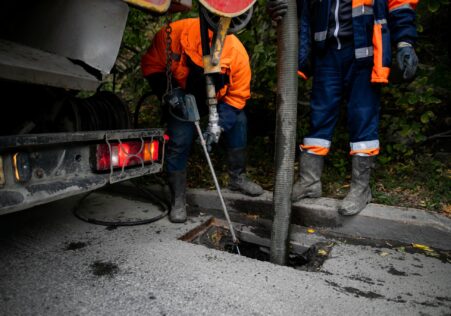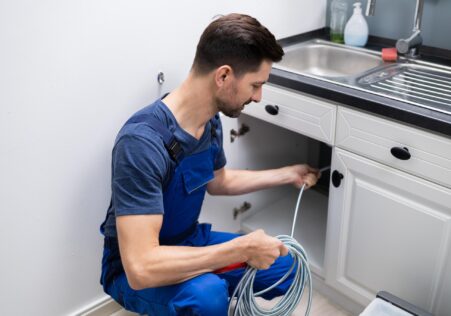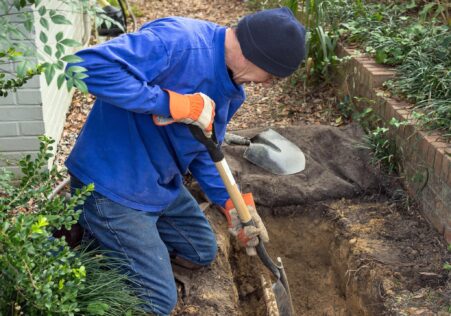What to Do When Your Toilet is Blocked: A Step-by-Step Guide

Toilet blockages can happen at any time and are a common problem for households. They can be unpleasant dirty, inconvenient, and messy, and require immediate attention. However, you do not always have to call an plumber immediately. In this blog post, we will guide you through some simple ways to clean your toilet in no time.
Key Takeaways
- Toilet blockages can be solved with the use of simple tools such as a plunger, baking soda
The tools you’ll need
Before we get started we must be prepared with these tools at hand:
- Rubber Gloves
- Plunger
- Baking Soda and Vinegar (Optional)
- The Hanger for Wire Coats or the plumbing Snake (Optional)
Step 1: Close the valve for water flow.
The first step you must do when confronted with a blocked toilet is to turn off the valve for water flow behind the toilet. This will ensure that no more water enters the tank as you work on unclogging it. The valve usually is situated at in the middle of the tank, on the other side.
Step 2: Make sure you are protected by wearing rubber gloves.
Hands must be protected from germs or bacteria present in your toilet by wearing rubber gloves prior to making use of any tool to clear the toilet.
Step 3: Use a plunger.
A plunger is undoubtedly the most effective tool to use for clearing up blocked toilets. First, push down gently on the plunger until all air escapes from it, then place it in the toilet bowl. Then, start to plunge continuously up and down for approximately 20 minutes. The suction caused by the movement of the plunger will assist in removing any blockages.
Tips:
- Use a firm but controlled movement.
- Cover holes around sinks or shower drains if they’re near to stop the air from escaping when you plunge.
Step 4: Make a baking soda and vinegar mixture.
If plunges don’t work, try this next tactic Pour half a cup of baking soda and 1 cups of white vinegar to the toilet. The mixture should sit for 15 to 20 minutes. It will begin to bubble, and when it stops then pour boiling water down (not overly hot) to clear the blockage.
Step 5: Use a coat hanger with wire or a plumbing snake.
If both plunging and baking soda/vinegar techniques have failed, then it is time to try an electric coat hanger or plumbing snake. You can straighten out the coat hanger’s cord until you have a thick, thin wire with hooks that are bent at one end or use to use the plumbing snake that was designed specifically for clearing drain clogs. Install the snake in the drain hole on your toilet, and twist to turn, push, to the point where you can feel a resistance. it’s the place where the blockage occurs. Try to break up the blockages by using a back and forth motion without damaging your drainpipe.
Note:
- Do not overdo pulling or pushing actions with force as they may make things worse
Step 6: Turn on the water supply and check the result.
Once you’ve cleared up any obstructions, it’s important to switch on your water valve that is behind your toilet. Then flush it several times to ensure that everything flows freely now!
| Tools | Description |
|---|---|
| Rubber Gloves | Hand protection from potential bacteria or germs present in the toilet bowl. |
| Plunger | Most effective tool for clearing up blocked toilets. Press firmly over the hole in your toilet bowl and plunge vigorously up and down for about 20 seconds. |
| Baking Soda and Vinegar | Mixture to use if plunging doesn’t work. Pour half a cup of baking soda and one cup of vinegar into the toilet bowl. Let this mixture settle for about 15 minutes, then pour hot water down (not boiling) to flush out the blockage. |
| Wire Coat Hanger or Plumbing Snake | Tools to use if both plunging and baking soda/vinegar methods have failed. Straighten the wire coat hanger until you have a long thin wire with a hook bent at one end or use the plumbing snake, which is designed specifically for clearing drain clogs. |
Common Questions & Answers
How do I know if my toilet is blocked?
Some of the more typical signs of a blocked toilet is when the water fills up to the top of the bowl after flushing. It is also possible to notice that the water drains slowly, or you may hear sounds of gurgling coming from the toilet.
What can I do if the toilet is blocked?
If you think the toilet is blocked and you are unable to flush it, do not attempt to flush it again as this can cause flooding. Instead, turn off your water source to the valve that is behind the toilet, and utilize a plunger to remove any obstruction. If this isn’t working then call Sydney Blocked Drain Plumbing for professional help.
How can I stop my toilet from becoming blocked?
Yes! There are numerous options to keep your toilet from becoming blocked. One of them is to avoid flushing items that are not biodegradable, such as sanitary products, wet wipes or cotton wool into the toilet. Avoid using oil or grease in the sink, as it can cause solidification and cause blockages to pipes.
What is the best time to call an experienced plumber about the problem of a toilet that is blocked?
If you’ve tried plunging your toilet, but it won’t unblock or you suspect that there’s an issue in your plumbing system causing frequent blockages, it’s time to call in a professional plumber, such as Sydney Blocked Drain Plumbing . We’ve had years of experience in dealing with all kinds of plumbing problems and can swiftly diagnose and correct any issue with minimal impact on your property.
What is the best frequency to get my drains cleaned?
It’s recommended that you have the drains cleaned out by professionals like Sydney Blocked Drain Plumbing every 1-2 years. This will reduce the chance of obstructions and keep your plumbing system operating smoothly. If you regularly encounter blockages in your drains or slow draining of water despite trying to avoid clogging them, then cleaning your drains every year could be beneficial.
These strategies are simple to execute, and most of these products are easily available in homes. If you’re having trouble with your toilets, don’t be panicking after attempting all these methods mentioned above – contact Sydney Blocked Drain Plumbing ‘s expert plumbers located in Sydney , if you’re looking for professional assistance with your blocked toilets.
Additional Information
- When to Schedule a Professional Drain Cleaning Service
- The Top Causes of Blocked Drains You Need to Know
- Cut Costs and Hassle with Trenchless Pipe Replacement for Condos
- CCTV Drain Inspections: The Key to Preventing Clogs and Other Plumbing Issues
- The Benefits of CCTV Drain Inspection: Beyond Unclogging Pipes
- CCTV Drain Inspection: A Detailed Guide on What It Is and How It Works
- How CCTV Drain Inspection Helps in Saving Time and Money on Plumbing Repairs?
- Common Drain Cleaning Mistakes You Need to Avoid
- The Ultimate Checklist for a Smooth-flowing CCTV Drain Inspection Experience
- Don't Let These Common Mistakes Clog Your Pipes








